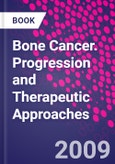Bone is a common site of cancer metastases - cancer cells commonly develop in bone and spread to other organ systems through the bloodstream. For example, the incidence of bone metastases in breast and prostate cancers is 70%, whereas it is only 30 to 40% in metastatic lung cancer. In clinical terms, bone metastases have substantial negative effects on a patient's quality of life and are a main cause of patient mortality.
Given the global prevalence of breast and prostate cancers, knowledge of bone biology has become essential for the medical and cancer research communities. This book provides, all in one resource, the most recent data on bone cancer development (cellular and molecular mechanisms), genomic and proteomic analyses, clinical analyses (histopathology, imaging, pain monitoring), as well as new therapeutic approaches and clinical trials for primary bone tumors and bone metastases.
Table of Contents
Section 1: IntroductionGenetic control, frequencies and epidemiology of bone cancers
The incidence and progression of metastatic bone lesions
Section 2: Bone microenvironment and bone cancer
Bone microenvironment and tumor growth
Osteoblast Differentiation and Cell Signalling
Osteoclast Differentiation and Function
Cytokines in bone remodeling and bone tumors
Proteases and bone tumors therapeutic approaches Section 3: Bone markers
Early bone metastasis
Bone remodeling markers and bone cancer
Proteomic of bone cancers
Genomic Alterations in Bone Tumors
Biology of bone tumors and new diagnostic tools
Gene profiling of osteosarcoma
Molecular pathology of osteosarcoma
Histopathology of prostate and breast metastases
Technical aspects: how do we best prepare bone samples for proper histological analysis?Section 4: Myeloma, odontogenic tumors and bone metastases
Multiple myeloma bone diseases
Osteolytic lesions
Bone metastases of prostatic cancer
Bone metastases of breast cancer
Section 5: Primary bone tumors
Osteosarcoma and osteoblasts: diagnosis and therapy
Ewing sarcoma family of tumors: diagnosis and therapy
Non-surgical treatment of chondrosarcoma: diagnosis and therapy
Chondrosarcoma of bone: diagnosis and therapy
Osteoclast-rich lesions of bone: diagnosis and therapy
Section 6: Imaging of bone cancers
Interventional Radiologic Techniques
Imaging of bone metastases
Diagnosis of bone metastases
Section 7: Pain control in bone cancers
Pain control with radiotherapy
Mechanisms and management of bone cancer pain
Malignant skeletal pain
Section 8: New therapeutic advances of bone cancers
Primary bone tumors and novel therapeutic approaches
Cytokine gene therapy in bone remodeling
Bisphosphonates
Multi-targeted approach
RANKL and targeted therapy
Apoptosis and drug resistance
Authors
Dominique Heymann Professor, Faculty of Medicine, University of Nantes; Head of Pathophysiology of Bone Resorption and Therapy of Primitive Bone Tumors, INSERM, Nantes, France. Dominique Heymann studied cell biology, biochemistry and immunology in INSERM (French NIH) unit 211 at the University of Nantes and received his Ph.D. in 1995. He was appointed Associate Professor in 2001 in the Department of Histology and Embryology. In 2009, he was awarded a personal Chair of Histology and Embryology.Currently he is the Quality Control Manager of the Tissue Bank and Gene and Cellular Therapy Unit at Nantes Hospital. He heads a laboratory research group (INSERM UMR 957) of 65 people at the Faculty of Medicine, where the pathogenesis of primary bone tumours, and more specifically, the role of bone microenvironment (osteoclasts, mesenchymal stem cells, OPG/RANK/RANKL, IL-6 and MCSF cytokine family) in tumour growth is studied.
In 2006, Dominique Heymann won the Paul Mathieu prize from the National Academy of Medicine for his work entitled "From the osteolytic process associated to primary bone tumors to the development of bi-therapies for osteosarcoma. He was on the national scientific advisory board of INSERM (2008-2012) and is now Co-Chairman of INSERM scientific commission n°5 ("Physiology and pathophysiology of endocrine, bone, skin and gastrointestinal tissues). He has authored approximately 180 publications in peer- reviewed journals, more than 300 abstracts and 20 book chapters. He is also Associate Editor of Life Sciences, Academic Editor of PLoS ONE, Editor-in-Chief of the Open Bone Journal and serves on the Editorial Board of Current Medicine Chemistry, European Journal of Pharmacology, and Journal of Bone Oncology.








